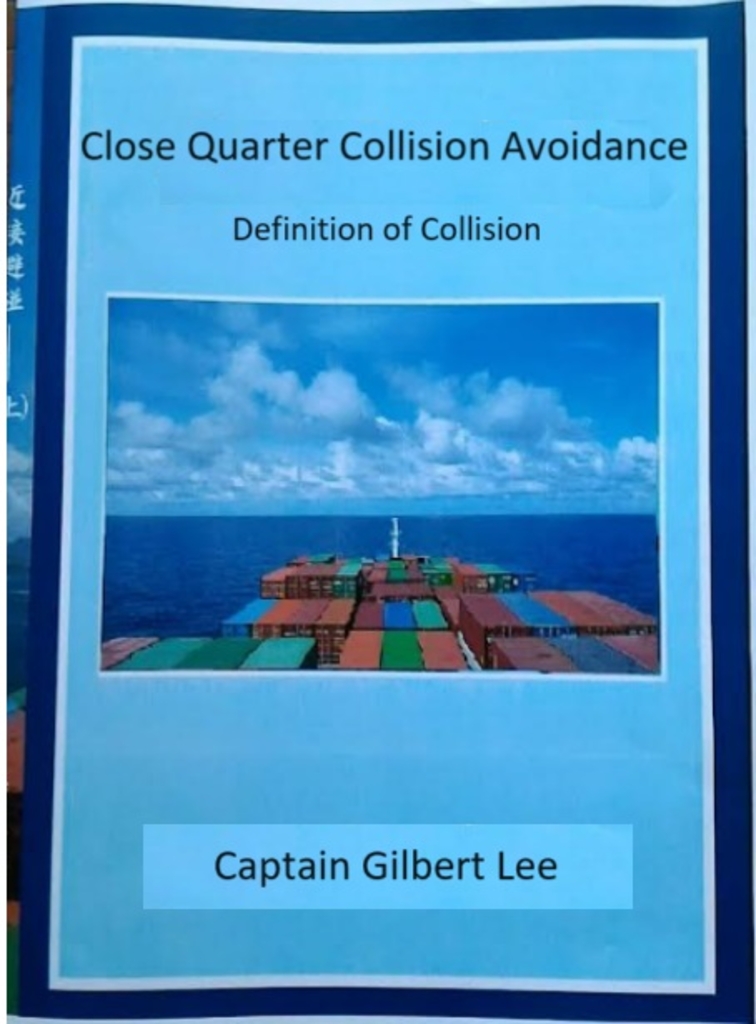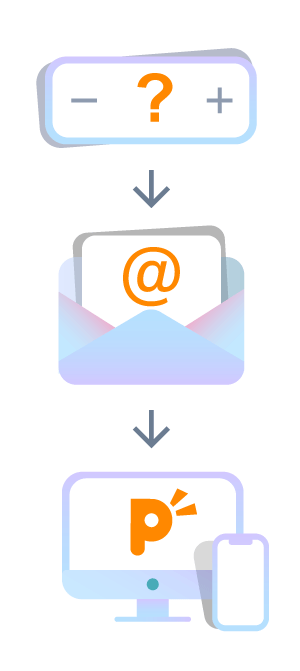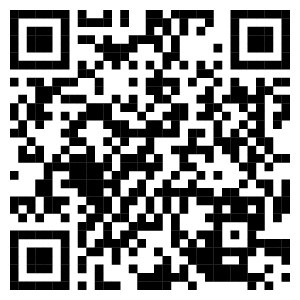definition of collision

DEFINITION OF COLLISION AT SEA
TWO OBJECTS PASS SAME PLACE AT SAME TIME.
This is quoted from JRC radar operation manual. We don’t collide very often in our daily life. We have the feeling of collision while walking in a crowded street. When it comes to the term of ship’s collision we have no sense. From last chapter we know from sense to feeling has a long way to go.
Let’s get the collision sense then. In the court precedent, there are many cases of damage to the ship or property categorized as collision like hit fixed or floating object (FFO). In this book, we will only refer it to physical contact between two vessels. How the collision happened? There are two important features of collision: at same place and at same time. If we want to avoid a collision at sea, we have two choices.
First: maneuver own ship to avoid passing same place.
Second: make sure own ship will not arrive collision space at same time with others.
TWO OBJECTS PASS SAME PLACE AT SAME TIME.
This is quoted from JRC radar operation manual. We don’t collide very often in our daily life. We have the feeling of collision while walking in a crowded street. When it comes to the term of ship’s collision we have no sense. From last chapter we know from sense to feeling has a long way to go.
Let’s get the collision sense then. In the court precedent, there are many cases of damage to the ship or property categorized as collision like hit fixed or floating object (FFO). In this book, we will only refer it to physical contact between two vessels. How the collision happened? There are two important features of collision: at same place and at same time. If we want to avoid a collision at sea, we have two choices.
First: maneuver own ship to avoid passing same place.
Second: make sure own ship will not arrive collision space at same time with others.
FOREWORD
Draft 9 th Aug 2017
When I first became a wtatchkeeping officer with my new class 3 certificate ( a long time
ago)
I would have been very grateful to have a copy of a book like this. It is much better to learn
from other people’s mistakes than to have a collision ourselves. In this well researched
volume Captain Lee provides a wide and varied collection of recent incidents which clearly
demonstrate that when it comes to collisions at sea there is no single solution which can
be applied to all situations.
I have corresponded with Captain Lee for some fifteen years and we cooperated in writing
Managing Collision Avoidance at Sea, a book which was published by The Nautical
Institute in the UK in 2007. The main focus of that book was ‘the observance of good
seamanship’ to ‘avoid close quarters situations’
Here in this new book Captain Lee concentrates on critical situations where immediate
action is required. In studying the incidents he has selected, it is evident that nearly all the
accidents occurred because watchkeepers made errors of judgement particularly relating
to relative speed, distances, and the manoeuvring characteristics of own ship and target
vessel. Fatigue may also be an issue
Nobody I know wants to have a collision, and so there is inevitably some human factor
behind the process of making decisions of which the officer concerned was unaware. A
significant part of this book therefore concentrates on the human element. The Human
Element is a difficult subject to teach, because whenever a student gets an operational
answer wrong it is too often considered
as a personal insult.
You can see from the text that Captain Lee demands attention to this subject. His
disciplined approach is there to make students and readers aware that all too easily they
can make mistakes
He writes with the best of intentions and I can honestly say that Captain Lee is never
vindictive. We have to be thankful such people devote their lives to seeking deeper
understanding of critical issues.
Seafarers are not alone in making errors of judgement and I often think of the quotation by
one of our great poets T.S.Eliot who wrote “However certain our expectations. The
moment foreseen may be unexpected when it arrives”
Here then are just three simple examples to illustrate how easy it is to make assumptions
which
may make a critical situation worse. The first concerns an educational deception. A cadet
learns
correctly that in accordance with the COLREGS that ‘when one of two vessels is to keep
out of the way, the other vessel shall keep her course and speed.’ Now suppose he is a
junior officer on watch being overtaken by one ship with a second ship approaching from
starboard on a steady bearing’ If the stand on rule is his dominant belief he is faced with a
dilemma which he cannot resolve.
We might smile at this stupidity because We know better, but this simple example raises a
serious issue. Recently we had an almost catastrophic near misses in the English channel
with a vessel crossing the separation schemes at right angles. The words in the
COLREGS ‘but if obliged to do so shall cross as nearly as practicable at right angles...’
This rule was being interpreted as a dominant belief by the watchkeeper that he had the
right of way. The critical situation was averted at the very last moment by the smart actions
of the watchkeeper on the other vessel approaching from starboard.
Dominant beliefs often imprinted at a sub-conscious level determine our behaviour in
everything from religion, politics, business strategy to cultural behaviour. Be aware that
formative assumptions
may need checking out. An ideal tool for this is of course a simulator. We also have to be
aware that
other watchkeepers may not share your values and understanding.
Let us consider a busy watch in a congested coastal area where the watchkeeper changes
the radar display from relative motion for collision avoidance to true motion for navigation
and is distracted by the electrician who has come onto the bridge to mend a fault. They
talk for minute or two by which time a collision situation evolves faster than anticipated.
The watchkeeper now in some urgency attempts to resolve a safe manoeuvre but forgets
the radar is on true motion. Of course
‘this would never happen to me’ would be a common response but mis reading of an
instrument is one of the most frequent causes of accidents in all walks of life. In this
respect the dominant belief may derive from something as spurious as computer games
where quick action is most important. However to stay alive on the bridge for a lifetime it is
vital to cultivate a habit of self checking comparing the screen display with the visual
situation through the bridge windows or asking for a second opinion by calling the master.
Thirdly and let us hope this does not happen, but when in extremis in a critical near
collision scenario the manoeuvre chosen to avoid the collision may make the situation
worse. When the rudder is put hard over it is the stern which moves furthest from the
centre line at the start of the turn not the bow. Here the dominant belief in a state of high
drama, probably a sub conscious reaction, might well be based on car driving experience
where turning the wheel moves the bonnet and the car in the right direction straight away.
Unless it is tested nobody knows including ourselves.
The only way to act rationally in critical situations is to practice scenarios regularly. This
does not happen at sea but in aviation pilots undergo simulator training every year.
For this lack of extreme pilotage in shipping we need to follow the strategy developed
Captain Lee to make sure we take avoiding action before the situation turns critical at
some seven ship lengths to TCPA. This practical approach to collision avoidance has
changed the way officers are trained and has saved many ships from having a collision
when give way vessels fail to take action. This forms an essential section in this new book.
Bridgework is team work and this relationship between the experience and the authority of
the master and the limited experience and junior position of the watchkeeper can be the
cause of is misunderstandings and disagreements. Captain Lee addresses these issues in
an eminently readable way which is full of wisdom covering the human element on which
subject he has become a leading authority.
Inevitably there can be tensions and differences of understanding in all critical situations
where time
is pressing. What Captain Lee has succeeded in doing in this illustrative book, is to
demonstrate
ways of establishing practical strategies for avoiding collision even when there is
uncertainty about what the other vessel is going to do and he overcomes the problems of
communication within the bridge team through his enlightened approach based upon his
human element experience. Above all
he reminds that we can always build a better future because deep down all mariners share
a common aim which is the ensure a safe and timely arrival at the next port.
Julian Parker OBE FNI Rtd
Formerly Secretary of The Nautical Institute
Draft 9 th Aug 2017
When I first became a wtatchkeeping officer with my new class 3 certificate ( a long time
ago)
I would have been very grateful to have a copy of a book like this. It is much better to learn
from other people’s mistakes than to have a collision ourselves. In this well researched
volume Captain Lee provides a wide and varied collection of recent incidents which clearly
demonstrate that when it comes to collisions at sea there is no single solution which can
be applied to all situations.
I have corresponded with Captain Lee for some fifteen years and we cooperated in writing
Managing Collision Avoidance at Sea, a book which was published by The Nautical
Institute in the UK in 2007. The main focus of that book was ‘the observance of good
seamanship’ to ‘avoid close quarters situations’
Here in this new book Captain Lee concentrates on critical situations where immediate
action is required. In studying the incidents he has selected, it is evident that nearly all the
accidents occurred because watchkeepers made errors of judgement particularly relating
to relative speed, distances, and the manoeuvring characteristics of own ship and target
vessel. Fatigue may also be an issue
Nobody I know wants to have a collision, and so there is inevitably some human factor
behind the process of making decisions of which the officer concerned was unaware. A
significant part of this book therefore concentrates on the human element. The Human
Element is a difficult subject to teach, because whenever a student gets an operational
answer wrong it is too often considered
as a personal insult.
You can see from the text that Captain Lee demands attention to this subject. His
disciplined approach is there to make students and readers aware that all too easily they
can make mistakes
He writes with the best of intentions and I can honestly say that Captain Lee is never
vindictive. We have to be thankful such people devote their lives to seeking deeper
understanding of critical issues.
Seafarers are not alone in making errors of judgement and I often think of the quotation by
one of our great poets T.S.Eliot who wrote “However certain our expectations. The
moment foreseen may be unexpected when it arrives”
Here then are just three simple examples to illustrate how easy it is to make assumptions
which
may make a critical situation worse. The first concerns an educational deception. A cadet
learns
correctly that in accordance with the COLREGS that ‘when one of two vessels is to keep
out of the way, the other vessel shall keep her course and speed.’ Now suppose he is a
junior officer on watch being overtaken by one ship with a second ship approaching from
starboard on a steady bearing’ If the stand on rule is his dominant belief he is faced with a
dilemma which he cannot resolve.
We might smile at this stupidity because We know better, but this simple example raises a
serious issue. Recently we had an almost catastrophic near misses in the English channel
with a vessel crossing the separation schemes at right angles. The words in the
COLREGS ‘but if obliged to do so shall cross as nearly as practicable at right angles...’
This rule was being interpreted as a dominant belief by the watchkeeper that he had the
right of way. The critical situation was averted at the very last moment by the smart actions
of the watchkeeper on the other vessel approaching from starboard.
Dominant beliefs often imprinted at a sub-conscious level determine our behaviour in
everything from religion, politics, business strategy to cultural behaviour. Be aware that
formative assumptions
may need checking out. An ideal tool for this is of course a simulator. We also have to be
aware that
other watchkeepers may not share your values and understanding.
Let us consider a busy watch in a congested coastal area where the watchkeeper changes
the radar display from relative motion for collision avoidance to true motion for navigation
and is distracted by the electrician who has come onto the bridge to mend a fault. They
talk for minute or two by which time a collision situation evolves faster than anticipated.
The watchkeeper now in some urgency attempts to resolve a safe manoeuvre but forgets
the radar is on true motion. Of course
‘this would never happen to me’ would be a common response but mis reading of an
instrument is one of the most frequent causes of accidents in all walks of life. In this
respect the dominant belief may derive from something as spurious as computer games
where quick action is most important. However to stay alive on the bridge for a lifetime it is
vital to cultivate a habit of self checking comparing the screen display with the visual
situation through the bridge windows or asking for a second opinion by calling the master.
Thirdly and let us hope this does not happen, but when in extremis in a critical near
collision scenario the manoeuvre chosen to avoid the collision may make the situation
worse. When the rudder is put hard over it is the stern which moves furthest from the
centre line at the start of the turn not the bow. Here the dominant belief in a state of high
drama, probably a sub conscious reaction, might well be based on car driving experience
where turning the wheel moves the bonnet and the car in the right direction straight away.
Unless it is tested nobody knows including ourselves.
The only way to act rationally in critical situations is to practice scenarios regularly. This
does not happen at sea but in aviation pilots undergo simulator training every year.
For this lack of extreme pilotage in shipping we need to follow the strategy developed
Captain Lee to make sure we take avoiding action before the situation turns critical at
some seven ship lengths to TCPA. This practical approach to collision avoidance has
changed the way officers are trained and has saved many ships from having a collision
when give way vessels fail to take action. This forms an essential section in this new book.
Bridgework is team work and this relationship between the experience and the authority of
the master and the limited experience and junior position of the watchkeeper can be the
cause of is misunderstandings and disagreements. Captain Lee addresses these issues in
an eminently readable way which is full of wisdom covering the human element on which
subject he has become a leading authority.
Inevitably there can be tensions and differences of understanding in all critical situations
where time
is pressing. What Captain Lee has succeeded in doing in this illustrative book, is to
demonstrate
ways of establishing practical strategies for avoiding collision even when there is
uncertainty about what the other vessel is going to do and he overcomes the problems of
communication within the bridge team through his enlightened approach based upon his
human element experience. Above all
he reminds that we can always build a better future because deep down all mariners share
a common aim which is the ensure a safe and timely arrival at the next port.
Julian Parker OBE FNI Rtd
Formerly Secretary of The Nautical Institute
Experience:
Bridge Simulator Instructor, EVERGREEN Seafarer Training Center, 6 years
■ Instructor, collision avoidance and human element, Master Mariner's
Association of the R.O.C. 3 hours ■
Instructor, Seaman DG cargo training course, National Taiwan Ocean University, 1 hour
BRM Instructor, EVERGREEN Seafarer Training Center, 4 years
Marine 3/2 Officer in OOCL, 3 years
Marine 2/Chief Officer in Evergreen, 6 years
Marine Master in Container Vessel, EVERGREEN Marine Corp., 7 Months
Shipside Chief Officer in Keelung port, 3.5 Years
Main Office Port Chief in Operation Department, 2 Years
Port Captain, Marine Technology Section, EVERGREEN Marine Corp.
■Department Head of Navigation Department, Taipei Marine Technology University
Port Captain, Marine Technology Section, WAN HAI line.
■ Graduated from the Department of Navigation, National Taiwan Ocean University 1980
Major Project attended:
Co-author of "Management Collision Avoidance at sea" 2007 Nautical Institute,
Bridge Simulator Instructor, EVERGREEN Seafarer Training Center, 6 years
■ Instructor, collision avoidance and human element, Master Mariner's
Association of the R.O.C. 3 hours ■
Instructor, Seaman DG cargo training course, National Taiwan Ocean University, 1 hour
BRM Instructor, EVERGREEN Seafarer Training Center, 4 years
Marine 3/2 Officer in OOCL, 3 years
Marine 2/Chief Officer in Evergreen, 6 years
Marine Master in Container Vessel, EVERGREEN Marine Corp., 7 Months
Shipside Chief Officer in Keelung port, 3.5 Years
Main Office Port Chief in Operation Department, 2 Years
Port Captain, Marine Technology Section, EVERGREEN Marine Corp.
■Department Head of Navigation Department, Taipei Marine Technology University
Port Captain, Marine Technology Section, WAN HAI line.
■ Graduated from the Department of Navigation, National Taiwan Ocean University 1980
Major Project attended:
Co-author of "Management Collision Avoidance at sea" 2007 Nautical Institute,
Details
Review
0 ratings
1 stars
0%
2 stars
0%
3 stars
0%
4 stars
0%
5 stars
0%
Write a review
Eligible to write reviews after purchasing products or add to Library







